❖ Guide for Drawing Fantasy Races ❖
These tutorial serves as the guidelines for those who believe that they can't make something new or unique for races and cultures, and who also believe that every idea has been done before. Like image below, those are the typical 'uniform' and stereotype kin of fantasy races.

Usually, if you don't have an idea, taking something physiological or psychological is a great starting point but also, using the usual form of combining human, nature, and animals will be what we're going to learn here and how.
Before we go dig into the nether world of Fantasy Races, we must admit that real animals have always played an important part in shaping history's most famous mythological beasts and races. The philosophy behind mixing real animal anatomies to create fantasy creatures is fascinating!
Introduction
While these creatures have taken the roles of either heroes or villains, it's their distinct anatomies that have helped define not only how they look, but also how they are perceived.
A Minotaur is a classic example of this, taking on the characteristics of both man and a bull. While a bull can be both physically powerful and dangerous, it's only when you add the intelligence and cunning of a man; it becomes an incredibly ominous being.
That very relationship between physical and psychological characteristics and the merging of animal's defining attributes; that have made for some of the most extraordinary creatures or race of Minotaur ever created by imagination of human artist.
[ Minotaur construction drawing ]

Although a set of defined guidelines has never truly existed, most mythological creatures have been created by piecing together particular animals' recognizable traits. For example like the legs of a cow as pictured from animated gif above.
[ Minotaur's redefining shapes ]
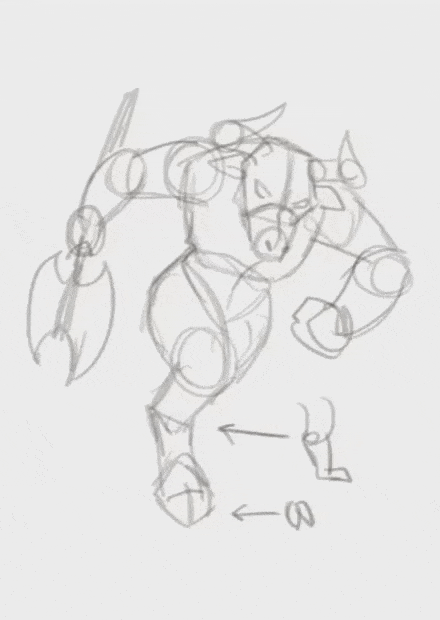
The traits chosen play important roles not only in the creature's overall appearance, but also define its capabilities and environment: strong legs for Minotaur to dash and trample around and also a big chest which captured the body of a female to make it looks humanoid.
I'm using [ Real Pencil ] to make a sketch with a dark brown color choice [ HEX: 56493D ] so it feels like dynamic to do the initial idea.
[ Minotaur's Value Shading ]

Aquatic creatures typically take on fishy or amphibian-like characteristics, while land creatures take on the characteristic found in birds or mammals. It could be said that it would make little sense to add a fishtail to a bird as it would probably serve no purpose, but then again, we are creating fantasy creatures.
Minotaur probably better equipped with light armor set, rather than other things for the body. Since it's already too strong and endurance, putting big armors could be massive but unnecessary.
I've been using [ Design Pencil ] to give some values for most of my concept drawings: especially dropping some shadows for several areas to give better look and feel for the characters or creatures that I made.
[ Finalizing Minotaur with Inking: Tapered Pen ]
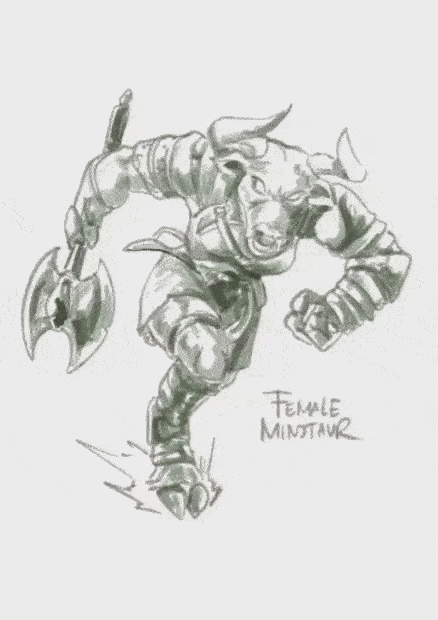
If you have a healthy imagination, there's no limit to the number of conceivable variations; however, I tend to believe some care should be taken when combining anatomies in order to add to a creature's overall cohesiveness.
[ Tapered Pen ] will be my only tool finalizing my sketch of Female Minotaur, it's always a good choice to make a final outline before go to the color, inking if you prefer the word like me. To define the shapes, shadows, and overall believably... You need a ton of practices and also see many references - especially for its outfit. (I can not share you the resources I saw right now from other website or else it will be against the rules of submitting Clip Studio TIPS).
So, how do we go about understanding which anatomies and characteristics work best in order to create fantasy creatures? Let's start by taking a look at their biology and environment with our next chapter.
Meanwhile here's the final outcome of Minotaur that I render with a bit of bluish muted colorization to the leather armor and white highlights only with [ Airbrush -> Soft ] :
The Reptilians
Next on our list of animal groups are reptiles, which are broken down into four specific orders:
1. Squamata (snakes, lizards, and amphibian)
2. Crocodilia (crocodiles, alligators, and caimans)
3. Chelonia (tortoises and turtles)
4. Rhynchocephalia (representing the single member: tuatara)
They're cold blooded animals and are characteristically known for their dry and sometimes scaly skin. One of the most well-known mythological creatures ever created is undoubtedly Medusa.
[ Let's practice: Gesture drawing ]

Medusa is a half woman, half serpent with snakes for hair. As the story goes, she was such an incredibly hideous and despicable creature that anyone who caught her eye would be turned immediately to stone.
Above is my first attempt to create an interesting gestures of Medusa (with less details of her snakes hair, face, and scales) using only [ Design Pencil ] in the process. As you can see, I'm focusing on a quick sketch that similar to an alphabet "S" to show you how to draw the snake appearance on Medusa's half lower body; while maintaining the woman body on top of it.
[ Refined drawing ]
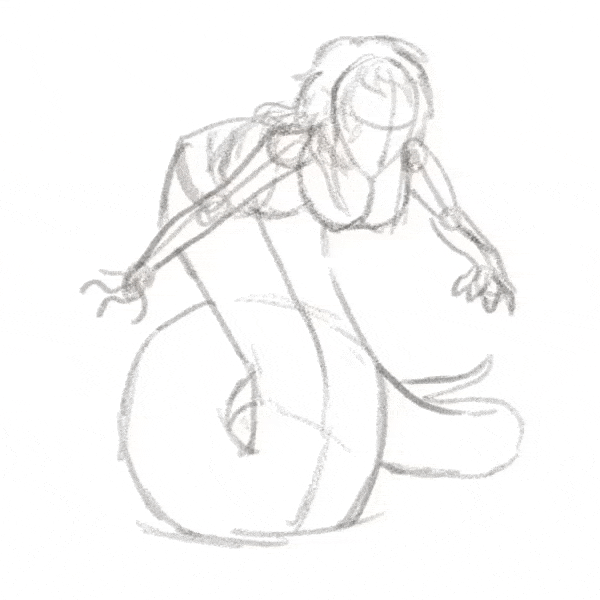
Sometimes, you could probably change the usual, stereotype of Medusa design which only appears like a gorgon-like monstrosity with her charming snake hair. If you think that's boring; you can try to make your own Medusa into some kind of Serpent race: a serpent lady.
Using [ Tapered Pen ] I refine my design pencil sketch and add some details to the figure such as pointy ears, fingers, more detailed body to the chest area and buttock without emphasize too much unnecessary or exagerrated drawing. A bit of finishing sketch with [ Design Pencil ] to overall design where the shadows fall would be a good addition.
[ Serpent Mage ]

Interestingly enough, reptilian characteristics have long been associated with things that are ugly or detestable. Image above represents the other 'temptation magic' that serpent lady had in her possession, with the curly snake tails in the end of the body, add some-kind of 'magic ball' in her hand to provoke the idea of a magic user; a venomous fruit if you might say so.
[ Design Pencil ] played the important role on every sketches that I had. Please limit the use of [ Eraser ] tool or simply [ Transparency ] in order to become confidence when designing character or creature concept art.
[ Refine The Design ]
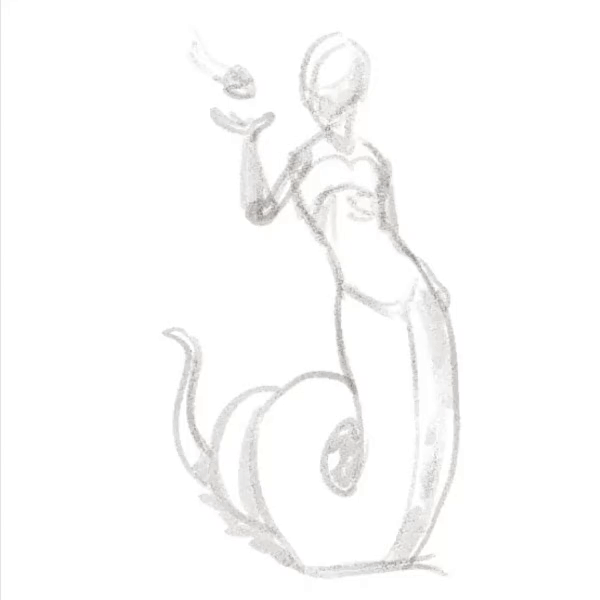
In the biblical history of Adam and Eve, it was the Devil disguised as a serpent that led to their temptation, fall, and expulsion from the Garden of Eve.
To define the characteristic of our serpent lady; I use [ Tapered Pen ] with a bit of [ Design Pencil ] strokes to add some values or volumes to the lower part of her body; representing the shadows will be essential to make the form believable although it's a fantasy character/race.
[ Practice Different Angles ]

Serpent Lady, is the fantasy female figure that I had the ideas originally from Medusa. But in the process of creating this figure, I stick to the beauty of woman body as well as the 'deadly charm' of her alluring appearance to the man.
Even now, phrases such as 'cold-hearted snake' are used to describe a loathsome of reprehensible character.
[ The Gorgon herself ]
Basically, below are some animated gifs that consist of preliminary sketch, refine sketch, inking respectively in order:



The Mammals
A large majority of creatures in myth and folklore take on the visual characteristics of mammals. Mammals are characterized by several distinct visual features, the most well-known of these, for most mammals, being the presence of hair, which can vary greatly among different species. They are also characterized by nursing their young. This explains their naming: the word mammal is derived from the Latin word 'mamma', meaning 'breast'.
[ Thumbnail Creation of Cheetahssassin ]

Using [ Design Pencil ] and a portrait (A4) paper, I usually design the composition or 'skeletal design' of the creature. Then refine the silhouette into little detail with [ Real Pencil ] before adding shadows later. Weapon is somehow necessary to fit the design, you can change the weapon to any tools that you wish; can be a rake for farmer, or even rifle for a hunter. It's up to your own or personal taste when creating your fantasy creatures / races.
[ Values Shading of the Cheetahssassin ]

[ Design Pencil ] always my best choice in every characters or creatures concept art. It gives me the satisfying shading result just as animated gif above shows. Hope that you can practice more with this default yet outstanding brush from Clip Studio Paint!
And here's the result of using strokes of [ Design Pencil ] :
As I stated earlier, defining characteristics are what help convey both physical appearance and temperament. The large muscular frame of a bull or horse, along with the characteristics of aptitude found in humans, are what help associate the idea of power and leadership to characters such as The Minotaur or Centaur. In an opposite extreme, cats or any feline creatures have been historically associated with signs of the occult or mischievousness.
[ Details with Tapered Pen ]

Below is the result of my line drawing.
To be honest; it took me a while (around 2 - 3 hours straight from Design Pencil until finished with Tapered Pen). It's all about the imaginations that you could put and tweak for the creature design (fantasy characters) - sometimes you need to know when to stop - or else you'll never finish your drawing. Trust me, over-detailing will burnout you for the long run and suddenly you will (strangely) lack of motivation to continue finishing what you've done so far.
Make it amazing or make it detail; but remember 'believability' is the core key.
[ Rendering sharp edges ]
Actually when you're done with the inking, it's time to do the coloring. But for this Cheetahssassin, I'd just focus on creating his sharp edges scythe using several techniques. More steps for the blocking & managing layers for color will be carefully explained within the next chapter of The Cervitaurs (part of Mammalians race but special edition).
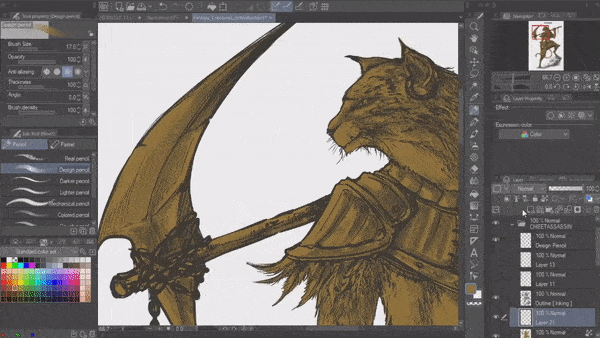
Using a new layer on top of ink layer, I add some white to create the visual highlights; by doing so; it gives you some 'punchy vocal points' to the overall drawing - that's why the name: HIGHLIGHTS-! The shiny part of the weapon can be drawn with [ Turnip Pen ] or any other sharp-edges brushes.
Then you can give little brush strokes with [ Design Pencil ] to add some textures into the scythe. And even you can add a little fracture on the edge of the scythe to make it much more interesting to look at.
It took me a while to complete Cheetahssassin drawing as shown from image below. I kind of running out of time in between my daily job as a Visual Art Teacher and completing Clip Studio Tips, however it's like a double-life for me to teach my students and create this content. Hope you can apologize for my unpolished result.
The Cervitaurs
As a half-human half-horse is known as a centaur, a half-human half-deer (or elk, or similar antlered ungulate) might be known as a Cervitaur. I'm taking the latin “ine” term for Cervidae here, cervine (as in equine or bovine). Rusitaur also works, see below.
That's assuming the body plan is similar to that of a centaur like the draft below:
Just for fun: here's a list of other “ine” terms you could abbreviate for other centaur-like creatures.
Anserine - geese (Anseritaur) | Aquiline - eagle (Aquilitaur, etc) | Assinine - donkey | Bovine - cattle | Cancrine - crab | Canine - dog | Cervine - deer | Corvine - crow | Equine - horse | Elapine - snake | Elaphine - deer | Feline - cat | Hircine - goat (capritaur works too) | Leonine - lion | Leporine - rabbit, hare | Lupine - wolf | Murine - rodent | Pavonine - peacock | Piscine - fish | Porcine - pig | Rusine - deer | Serpentine - snake | Ursine - bear | Vulpine - fox
And here's what I come up from one of list above. A Cervitaur:

/// A little bit of history or lore:
Elen of the Ways, a goddess who appears in Welsh myth but who may have pre-Celtic, indeed prehistoric origins, is pictured in all sorts of ways from 100% deer to a woman with reindeer antlers. (Female reindeer keep their antlers throughout winter. Draw your own conclusions about Santa's.) It would have been extremely important to early Europeans to know the migratory paths of reindeer and red deer.

There is a type of spirit in Scottish lore called a glaistig, who, like Elen, would sometimes be referred to as a “Green Maiden” or “Green Lady.” She took the form of a beautiful maiden from the waist up, and a goat or deer from the waist down.
As you can see from the image below, it's a final ink of Elen. I try to make a simple outlines without the nipples (because I don't really know the policy of having a nude drawing here, possible or not) - please understand that my drawing heres for educational purposes only.
/// Visual Silhouette
[ Note: Blocking method will be explained here! ]
Most of my creations, whether it's a character drawing or creature; I will block out everything in order to get the visual silhouette working fine before jump into the colors.
With a new layer, place it on top of ink layer; I start to make a 'new outlines' retracing all the lines I've made with highlight color: for example on the gif below: purple or any other high contrast colors you prefer.

Dropping the [ Fill ] tool inside the finished outlines will make the Visual Silhouette outcome just like the image below (I made it a bit of red purple) :
After you've done with [ Fill ] tool. You can try to move the filled layer below the ink layer. And you can see it better if some areas need to be removed. Before we go to color layer.
[ Coloring the Cervitaur - with my own preferred style ]

Coloring will be the most fun part, if you've already know how the layers works. This Cervitaur will essentially show you how to color the artwork simply by using several layer orders:
1. Highlight / details
2. Ink / Outline
3. Color < Clip to Layer Below >
4. Blocking
5. Sketch
6. Rough / Draft
7. Background

The Amphibians
The word amphibians is derived from Greek, meaning, 'both' and 'life'.
Like reptiles, they are also cold-blooded but are unique in their biology for their ability to adapt and reside on both land and water. Amphibians are divided into three groups : caudata or urodela (newts and salamanders), anura (frogs and toads), and gymnophiona or apoda (caecilians-amphibians that resemble earthworms or snakes).
/// Frog Warrior emerges!
One of history's most notable creatures with amphibian characteristics would have to be the frog-headed goddess Heket of Egyptian mythology. But since I've drawn so many goddess-like characters, let's draw a male warrior instead.
[ Basic shape structure ]

Talking about frog, many artists would create an agile-looking creature with slim feet and longer body maybe with thin sword. But for this time, I'd prefer a bulky design, equipped with light armor and two handed weapons; one axe and one sword.
Once again, [ Design Pencil ] plays an important role to give a basic structure for your drawing. Bigger circle appears to be the base of body while others will give you a good start to make the balancing composition of our Frog Warrior.
[ Refining the sketch ]

Heket was associated with matters of fertility and pregnancy and was believed by ancient Egyptians to be responsible for giving the breath of life to all unborn creatures. While our warrior supposed to be the defender and even a ruthless 'god of war' who destroys anyone who opposes him with sword and axe!
Using [ Real Pencil ] to create the details, I add an interesting insignia with Clip Studio Paint logo on it, a little accessory like a pouch (of herbs) hanging on the belt as well.
[ Detailing with ink ]

I recommend you to stay with your preferred [ Pen ] tool, whichever suits you the best. For me, it's always [ Tapered Pen ] and sometimes - when I feel bored - I change to [ Textured Pen ] because I think, these two default pen already enough for giving a detailed look onto your creation. Come on, it's unlimited possibilities you can get with only these 'infinite ink' Pens from Clip Studio Paint! Your hand will never getting dirty nor you should change the inks, right?
Tips: stay faithful with one particular tool (especially if we're talking about Digital Art) will reflect on your consistency of producing your artworks. Many artists struggle to find their 'style' while sometimes I realize that, simply limiting color pallet choices and tools can be the smartest first step towards finding your ONE TRULY ULTIMATE STYLE.
[ Here's my result from Tapered Pen ]
As you probably familiar with my common and (I admit) overused technique over and over again to block with a combination of [ Turnip Pen ] and [ Fill ] tool before coloring, let me just skip the repetitive process and jump into the result:

[ Determining shadows & highlights ]
Highlights will always be the most important aspect for our fantasy race. I strongly recommend everyone to add highlights only with a new layer, on top every layers while shadows supposed to be on separate layer (or in my case, I put them alongside the ink to make my layers appear less in every 'folder' of each characters) - everyone had their own preferences, I just share my suggestions since having a lot of layers will somehow confuse you and get in the way of creativity flows.
Advice on adding shadows:
1. Shadows not only black or dark grey as many people think of. You can add a bit dark blue or purple to give a shadow to the Frog's skin tones.
2. It could be at the same layer for giving additional depth of colors and represent that as shadows like example below with dark bluish green. Then after that, I give more depth with [ Airbrush -> Soft ] and scattered the dark brown to emphasize murky and muddy look of the Frog Warrior.

Interestingly, this idea was developed as a result of a frog's ability to live in two separate environments. In Egyptian history, frogs were believed to have been created from mud and water, since they would seem to appear from nowhere as a result of river floods during the rainy seasons. Our warrior has his ultimate features to stay hidden and disguised with the mud and ambush the enemy with preemptive strike strategy as well as a versatile fighter even underwater.
[ Finalizing color scheme ]
The Birds
Like mammals, a large portion of creatures in mythology and folklore have taken on the visual characteristics of birds. Biologically, birds are similar to mammals in that they are warm-blooded vertebrates.
[ Hawk Princess rough sketch ]

However, they differ from most mammals in that they reproduce by laying eggs. Birds are also unique from mammals (with the exception of bats, of course) because of their ability to fly.
When doing the rough image, I will definitely add the big wings to the design of my Hawk Princess obviously then make the boots somewhat special because I'll give the claws rather than just a long toenails for later detailed details.
You can see my result of drafting very rough below (without adding specific features) :
Characteristically, birds' most distinguishable features are their feathered wings, and mythological creatures such as The Pegasus or The Griffin share this distinction. The Griffin is an amalgamation of a lion and an eagle.
Keeping those best features in mind while creating the fantasy race will be a good starting point since you will think how to put those ideas without overthinking the whole concept about Aerial races too much, and here's my take on The Hawk Princess:
[ Visual features ]
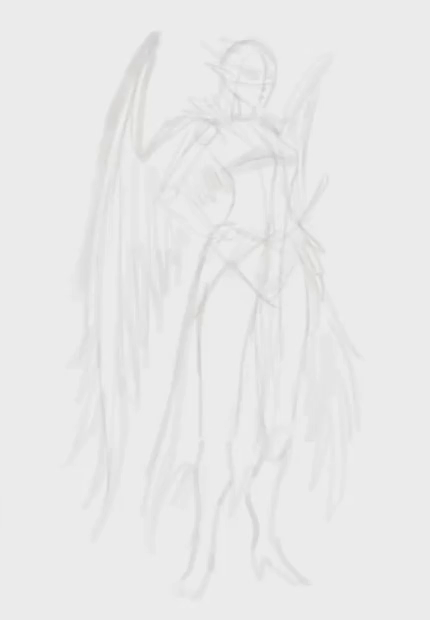
Lions have typically been associated with strength and considered the king of all beasts. Similarly, eagles have been considered the kings of the air maintaining a unique correlation between flight and freedom. This combination is unique in that this creature is a representative of two very powerful and sought after ideals.
But I prefer to create my own Fantasy Race approach to Hawk (not Harpy; I don't like harpies because of their weird look and the have no hands instead of winged hands). Maybe because I am a fan of superheroes characters; so I ended up creating this figure that looks like and inspired by... (You know that, I am in no place to give that answer because of CSP policy: no references can be put here).
Using [ Real Pencil ] with rather small size of the brush; I add some basic features for the draft;
1. The face will be filled with feathers that resemble the 'mask' of the Hawk Princess.
2. Huge wings inspired by Hawk: Hawks are a group of medium-sized diurnal birds of prey of the family Accipitridae. Hawks are widely distributed and vary greatly in size.
3. Leather with feathers armor; simple, lightweight, and sexy. It gives a prideful boost to the body of the Hawk Princess especially the chest area. She needs no trinkets, her beauty comes from the natural-born charming attitude.
4. Winged sword, the royal sword of Hawkingdom - made by the Hawksmith using special crystallized meteorite that has the durability of titanium. Swift and deadly, not too heavy so it will fits the Princess' sword-style.
5. Special boots of The Princess, I let the talons revealed. Because sometimes, the Princess will use her talons (even if it seems like a dirty play) to strike her enemies by surprise.
[ Inking the Hawk Princess ]

But I prefer to create my own Fantasy Race approach to Hawk (not Harpy; I don't like harpies because of their weird look and the have no hands instead of winged hands). Maybe because I am a fan of superheroes characters; so I ended up creating this figure that looks like and inspired by... (You know that, I am in no place to give that answer because of CSP policy: no references can be put here).
[ Blocking -> Coloring ]
You know the drill, after done with the ink (like the same repeated process) then I'll go with creating a new layer, rename it into blocking and move it on top of the ink layer.
With the same method of using the simple default [ Turnip Pen ] as well as [ Fill ] with brown color after done with the outlines then move the layer below the ink, after that I paint everything with [ Design Pencil ] only.
[ Fancy white back lighting through the character ]
This is just some additional technique which I'd like to share. At first, I doubt to share the animated gif (since it's around 8 MB and might took a while to upload/play) but then I edit this tutorial to give you some ideas of how I create the white back-lighting feel.

First, simply create a new layer on top of your ink layer. For me, I rename it to HIGHLIGHTS because I need this layer to serve as additional lighting as well as layer for detailing. You can see from animated gif that I use a bluish color to add extra cool color on the right side of Hawk Princess, especially the eyes, the wings, and some reflections to the outfit. It depends on the background, for this image; I go with white and blue since it will make sense if anyone asking that I try to give the sky reflections to the image of Hawk Princess after all.
Now I think I made this image for about 1 hour 45 minutes total. Straight from rough till the final back-lighting process with details here and there. And here's the final result:
The Insects
Insects are the arthropods that fall under the group known as hexapods. The word hexapod is derived from the Greek Hexapoda, meaning ‘six legs’, which is also one of the most distinctive features of most insects.
Other distinct features include the body, which is split into three segments -the head, thorax, and abdomen -as well as other parts such as wings or antennae.

There are also three smaller classes within the hexapod group, known as the springtails, proturans and diplurans that lack most of these recognisable 'insect' characteristics.
It could be said that insects are similar to reptiles in the way many people react to them, which is often in disgust. With the exception of maybe the butterfly, most insects have been looked at with general distaste. This could be due to their alien-like forms or their historical association with diseases.

It's this natural aversion that has been exploited many times over to create some of the most horrific creatures in popular culture. One of the most memorable examples would be the 1986 remake of the classic science fiction film The Fly, starring Jeff Goldblum, in which a scientist accidentally merges his body with that of a fly.
But little did I know about any films or movies were using figure of a half woman and half spider for the rest of her body. Personally I encounterd about broodmother or Spider Queen type of characters mostly from the video games (but most of them just a form of giant spider) - interestingly, although I wouldn't want to put the original source of information here, but I learnt to make this type of monstrosity race from Japanese image board.
[ The Black Widow ]

The Pisces
Fish are the largest group of backboned animals on the planet and the fact they live under water gives them unique traits. A typical fish is characterised by its ability to breathe using gills, having a scale-covered body, and the ability to manoeuvre using fins. While the majority of fish are cold-blooded, there are some warm-blooded species.
A myriad of ocean-dwelling creatures have had a long-standing part in myth and folklore. Tales of fearsome sea monsters are legendary and can be attributed to the appearance of large sea animals such as whales or giant squids.
[ Creature from the depth quick sketch + refine ]

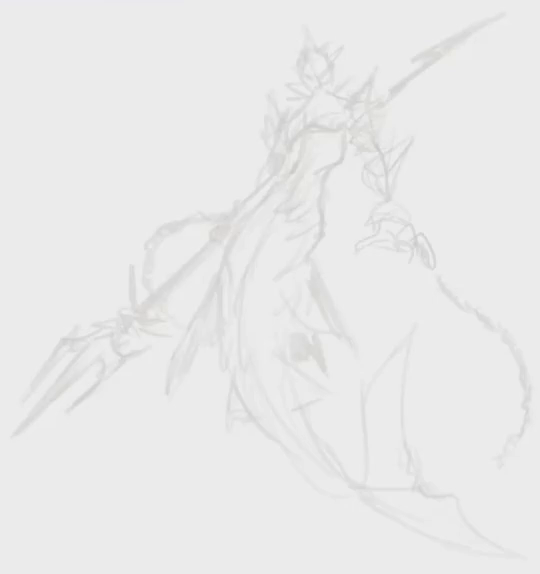
Arguably, the most notable of all sea creatures would have to be the Mermaid. Mermaid or sea nymphs (as some people refer to them) are legendary creatures containing the head and torso of a woman and the tail of a fish. In folklore, they have been described as enchanting and beautiful creatures known for their ability to lure sailors to their deaths with beautiful singing.
But for our fantasy race creation: mermaids was overrated, so let's go with the...
SHARKING
[ Concept art with Tapered Pen inking ]

This dichotomy between beauty and death has added to the long-standing appeal of this fantasy creature, making mermaids most memorable. Siren might be lovable but for Sharking... It's going to be your worst nightmare from the depth of the ocean! Unless you think it's just like a prank from urban slang dictionary...
But anyway, I'm running out of time... So I summon you...
S H A R K I N G
The Authorian

Lastly, the Authorian is not a fantasy race. Instead it's about me, Futopia - the fantasy race artist by night - a visual art teacher by day. Living in this earth that has been struck by pandemic almost half a year... I spent my time creating cute artworks whilst teaching my students how to draw from basic shapes using The 7 Elements of Art.
Somehow, especially for grade 9 until 12: honestly I teach them a little bit of creating fantasy art because I'd like to see the students put their creativity in between the lesson about still life, realism, and others that might be boring for them- following the standard guidelines.
Using Clip Studio Paint as one of my favorite tool to share what I can do as 'a method of live drawing' while explaining the students with the lesson plan that I had to follow using Cambridge curriculum of IGCSE Art & Design.
THANK YOU VERY MUCH FOR READING!!

















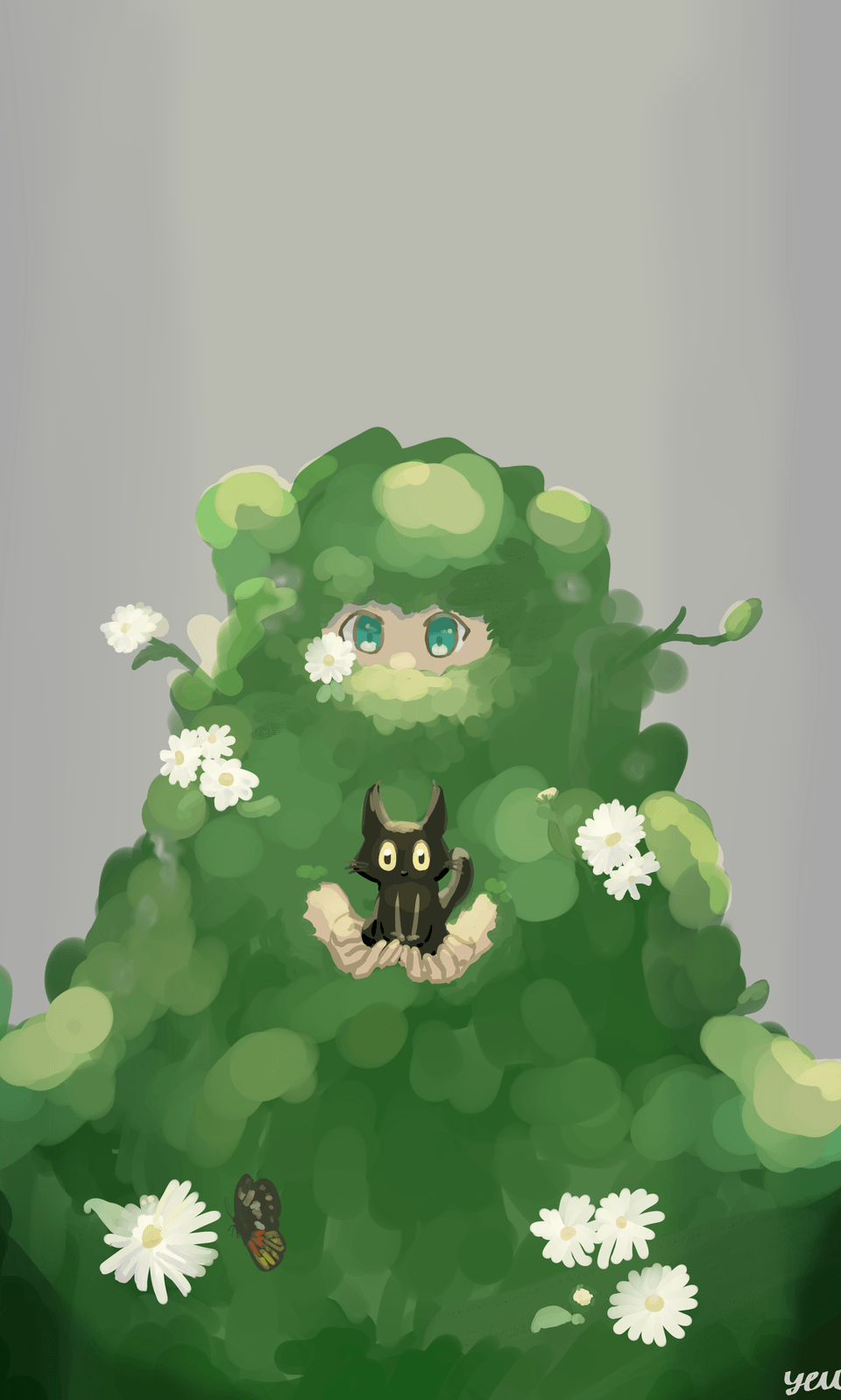



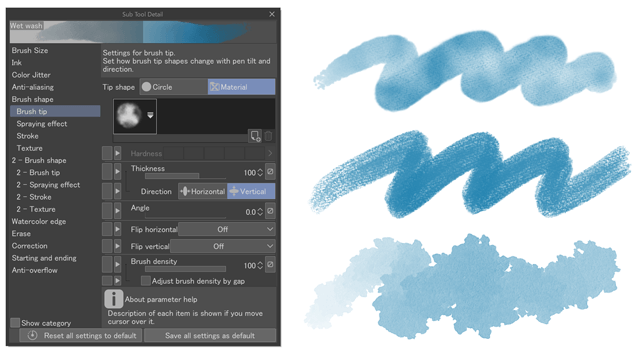


댓글